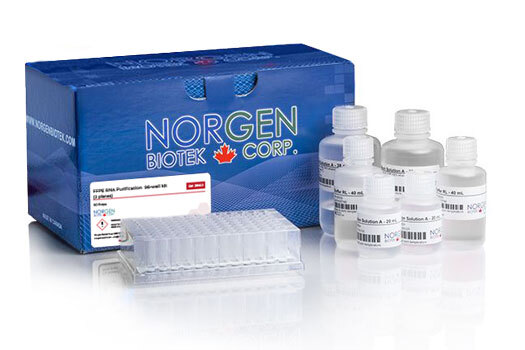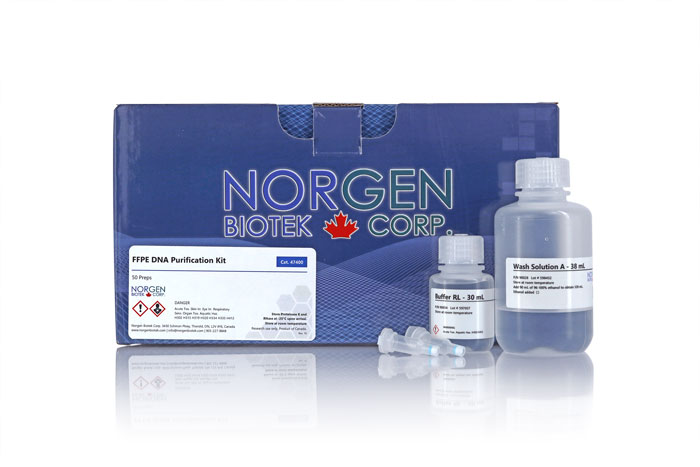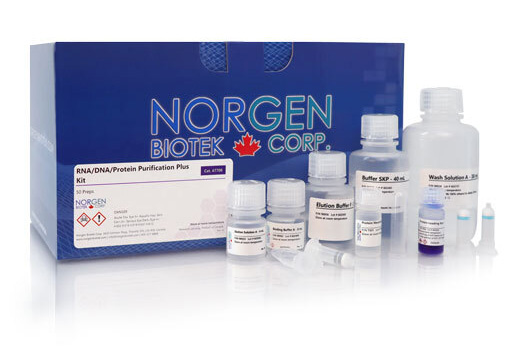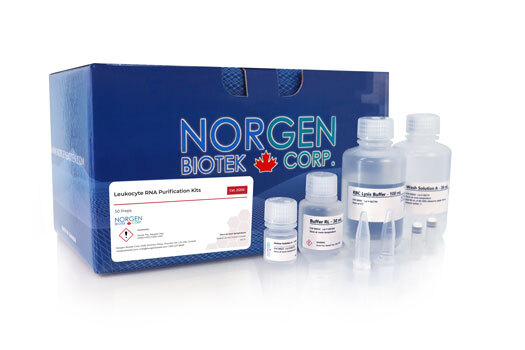FFPE RNA/DNA Purification Plus Kit
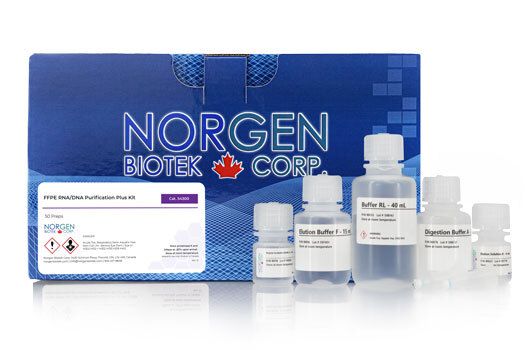
For research use only and NOT intended for in vitro diagnostics.
Formerly Cat. 25000
CE-IVDD marked diagnostic version available here
FFPE RNA/DNA Purification Plus Kit
Register today to receive an exclusive 15% off* on your first order.
Supporting Data
Figure 1. Superior Recovery of High Quality RNA and DNA from FFPE Spleen Tissues. Norgen's FFPE RNA/DNA Purification Plus Kit isolates FFPE RNA and DNA that exceeds the yield of competitors. Total RNA and DNA was isolated from equal amount of hamster FFPE spleen sections (20 micron thickness) using Norgen's FFPE RNA /DNA Purification Plus Kit and a leading competitor’s kits. Triplicate isolations were performed for each product. The top graphs demonstrate the mean yield of RNA (Panel A) and DNA (Panel B) according to NanoDrop measurement. The bottom graphs showed the mean 260:280 ratio and 260:230 ratio of RNA (Panel C) and DNA (Panel D) according to NanoDrop measurement. Norgen's kit consistently purified total RNA and DNA with a higher yield and higher quality than for those obtained using the market competitor's kits.
Figure 2. Recovery of High Quality DNA and True Total RNA including microRNA from Hamster Spleen. Genomic DNA isolated using Norgen's FFPE RNA/DNA Purification Plus Kit is of high quality with effective qPCR amplification. Panel A showed that in a qPCR using primers against the 5S rRNA gene using equal amount of FFPE DNA as template, the DNA isolated with Norgen's kit showed better amplification (lower Ct value). Moreover, Norgen's FFPE RNA/DNA Purification Plus Kit isolates true total RNA including microRNA. With the same amount of RNA as template in RT-qPCR reactions for transcripts of miR-21 (Panel B for microRNA) and beta-Actin (Panel C for mRNA), RNA isolated by Norgen showed better amplification in beta-Actin and significantly better in miR-21 microRNA.
|
Kit Specifications
|
|
|
Maximum Binding Capacity
|
Up to 35 μg RNA
Up to 10 μg DNA |
|
Maximum Column Loading Volume
|
600 μL
|
|
Size of RNA Purified
|
All sizes, including small RNA (< 200 nt) |
| Maximum Amount of Starting Material |
4 sections <20 μM thick
10 mg of unsectioned block |
Storage Conditions and Product Stability
All solutions should be kept tightly sealed and stored at room temperature. The DNAse I and Proteinase K should be stored at -20°C upon arrival. This kit is stable for 1 year after the date of shipment.
Component | Cat. 54300 (50 preps) |
|---|---|
Digestion Buffer A | 2 x 25 mL |
Buffer RL | 40 mL |
Enzyme Incubation Buffer A | 6 mL |
Wash Solution A | 2 x 38 mL |
Elution Solution A | 6 mL |
Elution Buffer F | 15 mL |
Proteinase K | 2 x 12 mg |
DNase I | 1 vial |
RNA Purification Micro Columns | 50 |
DNA Purification Micro Columns | 50 |
Collection Tubes | 100 |
Elution Tubes (1.7 mL) | 100 |
Product Insert | 1 |
Documentation
FAQs
Plus
Poor DNA or RNA recovery may be caused by one or more of the following:
- Incomplete lysis of cells or tissue.
Ensure that the appropriate amount of Digestion Buffer A and Proteinase K was used. Increase the incubation time. - Column has become clogged.
Do not exceed the recommended amounts of starting materials. The amount of starting material may need to be decreased if the column shows clogging below the recommended levels. See FAQ related to “Clogged Column” below. - An alternative elution solution was used.
It is recommended that the Elution Solution A and Elution Buffer F supplied with this kit be used for maximum RNA or DNA recovery. - Ethanol or Buffer RL was not added to the lysate.
Ensure that the appropriate amount of ethanol and Buffer RL is added to the lysate before binding to the column. - Ethanol was not added to the Wash Solutions.
Ensure that 90 mL of 96 - 100% ethanol is added to the supplied Wash Solution A prior to use. - Low nucleic acid content in cells or tissues used.
Different tissues and cells have different nucleic acid contents, and thus the expected yield of nucleic acid will vary greatly from these different sources. Please check literature to determine the expected nucleic acid content of your starting material.
Clogged columns may occur due to:
- Insufficient solubilization of cells or tissues.
Ensure that the appropriate amount of Digestion Buffer A with Proteinase K added was used. Increase the incubation time. - Maximum number of sections or amount of tissue exceeds kit specifications.
Refer to specifications to determine if the amount of starting material falls within kit specifications. - Clarified lysate was not used for the binding step.
Ensure that after the lysis step, the sample is centrifuged if significant precipitates are present, and that only the clarified lysate is used in subsequent steps. - Centrifuge temperature is too low.
Ensure that the centrifuge remains at room temperature throughout the procedure. Temperatures below 15°C may cause precipitates to form that can cause the columns to clog.
Eluted RNA can be degraded due to the following factors:
- FFPE sample is old.
The quality of RNA purified may drastically decrease in old samples. For best performance, freshly prepared samples are highly recommended. - RNase contamination.
RNases may be introduced during the use of the kit. Ensure proper procedures are followed when working with RNA. Please refer to “Working with RNA” at the beginning of this user guide. - Too long incubation of lysate at high temperature.
In order to maintain the integrity of the RNA, it is important that the procedure be performed according to the time indicated. This is especially important for the lysate preparation step when the sample is incubated at 55°C and 80°C for 15 minutes each. Incubation beyond the time indicated may lead to fragmentation of RNA. - Improper storage of the purified RNA.
For short term storage, RNA samples may be stored at –20°C for a few days. It is recommended that samples be stored at –70°C for longer term storage. - Prolonged incubation at 55°C.
In order to reverse formalin crosslinks, an incubation at 55°C is required which may lead to degraded RNA.
Nucleic acids may not be performing well in downstream applications due to the following:
- Nucleic acids were not washed 3 times with the provided Wash Solution.
Traces of salt from the binding step may remain in the sample if the column is not washed 3 times with Wash Solution. Salt may interfere with downstream applications, and thus must be washed from the column. - Ethanol carryover.
Ensure that the dry spin under the Column Wash procedure is performed, in order to remove traces of ethanol prior to elution. Ethanol is known to interfere with many downstream applications. - Formalin crosslink was not completely reversed.
Ensure sufficient incubation at 80°C or 90°C is performed to remove formalin crosslink.
The contamination with genomic DNA may be due to the use of large amounts of starting material. To address this issue, it is recommended to perform RNase-free DNase I digestion on the RNA sample after elution to remove genomic DNA contamination.


